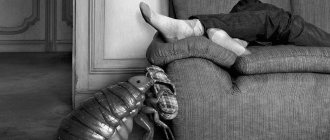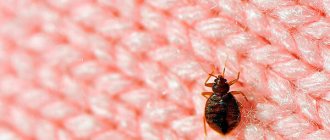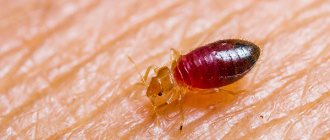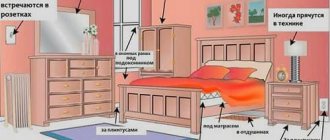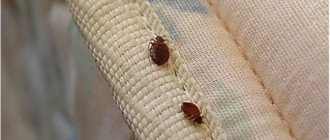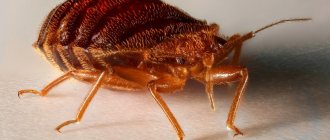- By Vil Malinoshevsky
- About bedbugs
If you are unable to remove bed bugs for a long time, it is because there are many misconceptions about these insects. Such myths about bedbugs, which for one reason or another have become established or simply appear in the minds of most people, lead to very real mistakes when destroying these parasites. And these mistakes become the immediate reasons why bedbugs cannot be removed.
Moreover, sometimes this reaches the point of absurdity: with the right approach, a person free from these myths removes bedbugs in 2 hours of proper treatment, while another, captive of these misconceptions, struggles with them for months, or even years, and cannot remove them .
Such a result is a matter of two hours with the right approach and the absence of misconceptions
Moreover, our subscribers and viewers very often write to us, ask us questions that clearly contain such myths, and we have already collected a whole collection of misconceptions from such questions. And many of these misconceptions are typical and are repeated many times by different people. By analyzing these misconceptions, we understand what mistakes a particular myth leads to, and how ultimately, due to such a misconception, a person cannot remove bedbugs.
Let's now look at all these myths in order, figure out why they prevent people from destroying bedbugs, and then refute them and try to find the truth.
Myth 1: Bed bugs only live in beds
Likewise, we come across similar but less common options: couch bugs only live in the sofa, bed bugs only live in the bed, and so on. In general, people believe that the bed bugs that bite them live only in sleeping areas. This myth is due to the fact that bedbugs bite people only when people sleep in their sleeping places and it seems that they also live only in these sleeping places.
And this misconception leads to the fact that people try to destroy bedbugs only in sleeping areas. Only the sofa or just the bed is treated with the same insecticides, or, for example, steam from a steam generator, and the person believes that after such treatment the bedbugs should disappear.
But they do not disappear, because in fact, in most apartments and houses some of the bedbugs live outside the sleeping areas. If a full inspection of the premises is carried out before baiting, then bedbugs are usually also found behind baseboards, behind furniture, behind household appliances, and sometimes even behind loose wallpaper, in computer system units and in books. It is clear that if in such a situation only the sleeping place is treated for them, all other bedbugs will remain alive and will safely bite a person and reproduce even after disinfestation. That is, it will not be possible to withdraw them.
Another way this misconception goes wrong is that people throw out a sofa and assume that all the bedbugs have gone with the sofa. You probably already understand what the result is.
Therefore, in order to destroy bedbugs, they need to be poisoned not only in sleeping places, but wherever they are. To understand where they are and what places need to be treated, before treatment you need to inspect all the cracks, niches and cavities in the room into which bedbugs can theoretically climb.
After this, you will know where the bedbugs are, destroy all of them wherever they hide, and there will be no more of them left in the room.
How to secure your home?
First of all, you should take care of preventing bedbug infestation in your home.
- If you have recently moved to a new place, it is best to make repairs right away. Parasites love to live in cracks in walls, floors and ceilings, especially in wooden houses. Each crack must be carefully sealed, especially if you live in an apartment building - insects can enter through various openings from neighbors or from the street.
- After spending the night in a suspicious place, you should thoroughly shake out your clothes and wash them. It is better to spray bags and backpacks with a special insecticide.
- When buying used furniture, especially if it has soft upholstery, you need to check it for uninvited guests. The same goes for used equipment, clothes, books and soft toys.
- It is worth regularly doing general cleaning, thoroughly cleaning the space behind and under sofas, cabinets and other furniture. The upholstery of sofas and armchairs, as well as mattresses, should be thoroughly vacuumed. Such cleaning is useful for preventing infection and will also help to detect a fresh colony of parasites in time.
If insects do infect the premises, then only total disinfestation will help, which is best left to professionals.
Myth 2: Bedbugs somehow selectively bite people
It is due to the fact that in the same room, traces of bedbug bites are found on some people, but not on others. Accordingly, people decide that bedbugs bite some people and leave others alone. And then they build whole theories about how bedbugs choose a victim: by blood type, by smell or by other characteristics.
We have devoted a separate article to this misconception. You can watch it.
In short, bedbugs bite all people equally intensely, it’s just that in some people their bites cause pronounced reactions with noticeable consequences in the form of bumps and itching, while other people are insensitive to their bites, and such bumps and itching do not remain on their body. Accordingly, in the morning after equally strong bites from all the people in the apartment, some have bite marks on their bodies, while others do not. This is all the more relevant when you consider that more than half of people either do not feel bedbug bites at all, or the consequences of these bites go away before the person wakes up.
There are suggestions that bedbugs are somehow a little more attracted to certain people, but this difference in attractiveness is practically not reflected in the intensity of bites. That is, in an infected room, all people will be bitten, just one person will be bitten by 20 bedbugs per night, and another by 18. With the same sensitivity, you will not notice the difference between the number of bites, but with different sensitivities, the differences in the consequences of bites are obvious.
This myth leads people to believe that bedbugs live in the same sofa, or in the same room where people sleep and constantly develop bite marks. But in a sofa or in a room where a person who does not suffer from bedbugs sleeps, these parasites are not present. Accordingly, they poison bedbugs only in one sofa or in one room; insects in other places remain unharmed and cannot be removed.
The protection against this misconception is the same as in the previous case: a complete inspection of the apartment and all the places where bedbugs can hide. After such an examination, it will become clear where they need to be poisoned in order to destroy everyone.
How else do bedbugs harm humans?
Parasites have a particularly bad effect on pregnant women. Allergic diseases are even more likely during this period, and taking medications is extremely undesirable. The stress that a pregnant woman experiences, as well as insomnia due to parasites, also negatively affects the fetus. Any person with frequent bites has a weakened immune system, people with somatic diseases may have a constant rise in temperature, and infectious diseases occur more often.
Why are bedbug bites dangerous to humans? In severe cases, when we are talking about a high degree of population of the apartment with bedbugs, they can even lead to iron deficiency anemia. Although such cases are rare, they are still possible. One insect drinks about 7 μl of blood per night, so with regular and numerous bites, a weakened person or small child is quite likely to develop anemia.
Myth 3: Bedbugs can be repelled with herbs, essential oils, vinegar or electronic repellers
This is not even a myth, but the blue dream of most people who find bedbugs in their house. Like, while everyone around is pouring stinking insecticides into their apartments, I’ll take a bouquet of tansy, put it under the bed, and the bedbugs will run away in panic to the neighbors, or will start to climb out through the windows and throw themselves into the abyss.
With the same calculation, people buy ultrasonic or electromagnetic repellers and plug them into a power outlet.
Alas, such expectations are nothing more than self-deception. We have never met a person for whom repellents - any, both traditional and modern electronic - could help get rid of bedbugs. And we have never heard of such situations from any of the clients of online stores. Even theoretically, it is impossible to imagine a situation where, with the regular presence of a person in an apartment, bedbugs would leave, frightened by the smell of tansy or wormwood. But they don’t react to ultrasound at all - it affects them in the same way as Wi-Fi affects a person.
By and large, all this device does is blink a light bulb, for which a person pays money
The problems that people face because of this myth are obvious: bedbugs simply do not disappear when using such products. Sometimes, immediately after placing such repellents in the apartment, the intensity of bedbug bites may decrease slightly, but after two or three days it is completely restored.
Therefore, in order to get rid of bedbugs, they must be destroyed. Not to scare away, not to drive away, but to exterminate.
Myth 4: Bed bugs are microscopically small and impossible to see.
A lot of people really think this way. As a rule, this happens when people are bitten by fleas: in many cases of such bites, the person does not have time to notice the parasite, and while he involuntarily scratches the bite site, the flea is already detached from the skin and runs away, or rather, jumps away.
The most typical situations here are:
- A person sits down to watch TV in the evening and feels a bite on his leg, scratches it, examines it and sees a swelling. At the same time, he does not have time to notice the insect itself;
- A person gets into a car and feels insects begin to run along his legs, after which painful bites begin. By the time he gets out of the car and rolls up his trouser legs to inspect his legs, the fleas are already falling off;
- People feel similar bites in the garden.
In all such situations, it is definitely not bedbugs that bite a person, if only because bedbugs do not touch a sleeping, moving victim at all, much less they will not attack in sunlight or the lights are on. Moreover, a bug is not able to escape from the body so quickly that a person will not have time to notice it.
Most of all, such situations resemble flea attacks.
Firstly, fleas can bite during the day and attack active, awake, moving hosts.
Secondly, they very quickly jump away from the bite site when there is danger and you really may not have time to notice them.
But the main thing is that they are small, much smaller than bedbugs, and people with poor eyesight may not even be able to see them on the skin.
The bugs are quite noticeable. Their smallest nymphs are slightly smaller than a flea, but such nymphs attack only at night. Adults and larger nymphs are about the size of a ladybug, but with a flatter body. They can be seen with the naked eye.
Consequently, in all situations in which it seems that some microscopically small bugs are biting, in reality it is either fleas, body lice, or rarer parasites who are biting.
Due to such errors, the room may be processed incorrectly. To remove fleas, you need to treat pets' resting areas, cracks in the floor and baseboards. To remove body lice, you need to treat clothing and bedding. If people mistake these insects for bedbugs and fight them as if they were bedbugs, then they treat the places where the bedbugs hide, and the parasites themselves - fleas or lice - remain unharmed. And therefore, then they continue to bite.
Therefore, we remember: bedbugs can be seen with the naked eye. If this cannot be done, then it is not bedbugs, and you need to figure out who is actually biting, and only after that take measures to destroy the detected and correctly identified parasites.
Ways to fight
Controlling a bed bug infestation is very difficult and is best left to dedicated pest control companies that have both professional, modern insecticides and application equipment to effectively treat the various places where the insects hide.
A pest control company representative should inspect the property and instruct you on pre-treatment steps. For example, eliminating or at least reducing clutter in the areas being treated is a necessity, and contaminated bedding should be removed and washed in hot water before the infestation is treated, and then everything should be washed and dried again.
Myth 5: Bed bugs jump
This is an analogue of the previous misconception. It occurs when a person sees an insect that bites him, tries to catch it, and the insect jumps, and does it so quickly that it seems that it simply disappears from the place where it was sitting before. At the same time, the person either does not know anything about fleas, or is sure that fleas in the room do not bite, and if someone here attacks a person, then it is bedbugs. Accordingly, he believes that these are some special jumping bugs, or simply concludes that ordinary bedbugs can jump.
The result of this misconception will be the treatment of insects in sleeping areas where fleas do not live (the person thinks that they are poisoning bedbugs), and untouched places of their usual habitat - baseboards, cracks between boards in the floor, resting areas for pets, carpets and dusty corners . Consequently, fleas do not disappear after such events.
In reality, bedbugs cannot jump due to the weakness of their legs. If the insect is jumping, then it is not a bug. Indoors it can be either crickets or fleas, and only fleas bite people. To destroy them, you need to find places where both adult fleas and their larvae accumulate - the latter can swarm in dust, in dirty corners, in accumulations of garbage, in the latrines of pets. And after the examination, all these places need to be treated with means to kill fleas.
Myth 6: Bed bugs have adapted to insecticides and cannot be killed by anything.
This myth circulates among independent bedbug fighters as a kind of justification for their own unsuccessful attempts to poison insects. They say that bedbugs do not take insecticides, and therefore it is impossible to remove them, and the only hope left is for some kind of super-powerful remedy that the parasites have never encountered before.
In reality, this is not an absolute myth, because bedbugs in certain places and cities do sometimes show resistance to certain insecticides. For example, studies show that in several psychiatric hospitals in Moscow, bedbugs are resistant to fenthion; in some areas of Moscow, parasites resistant to cypermethrin are regularly observed. That is, such stability is real.
At the same time, the number of such resistant bugs is very small. The same studies that identify insecticide-resistant populations show that the proportion of such resistant insects does not exceed a tenth of a percent, and usually even less. At the same time, bedbugs that are resistant to some insecticide are usually concentrated in separate places where their ancestors once appeared, who inherited such resistance.
In fact, this means that out of several thousand apartments, only one can contain bedbugs that are resistant to one product. And they still have to be seriously lucky for you to decide to poison them with a drug based on exactly the active ingredient that does not take them.
The consequence of such a misconception is a person’s reluctance to poison bedbugs at all, or attempts to fight insects in other, less effective ways. Even if a person finds a new remedy and tries to use it, he does it without much hope of results, simply carelessly, without opening the hiding places of insects, without treating all their shelters. As a result, the parasites are not destroyed.
Interestingly, this myth is very easily refuted. Just take a bedbug from your apartment, put it in a jar and spray it with your chosen baiting agent. If he dies from it within 2-3 hours, it means he has no resistance. At the same time, resistance in bedbugs develops in general throughout the entire population, which means that if one individual does not have it, then neither do the others. And the exact drug that killed the insect in the jar should also kill other bugs in the room. Even if bedbugs are resistant to a particular drug, it is enough to take a product based on another active ingredient and poison them with it - cases of resistance to several insecticides at once are extremely rare.
In practice, out of thousands of treatments, we encountered such resistant bugs literally several times. The likelihood that you have just such insects in your apartment, resistant to one insecticide, is very small.
Most likely, your bedbugs can be poisoned with most standard means. And if you can’t do this, then the problem is not in the product or resistance to it, but in the quality of the treatment itself.
Very often, by the way, we are told that they took the product, treated the apartment with it, the bedbugs disappeared for several weeks, and then began to appear again. And they conclude that the remedy did not work. This is not true. If the bedbugs are gone, it means the product worked - this is exactly the effect it should provide. The product kills those bedbugs that already live in the room, but protects the room from re-infestation. And if the bedbugs disappeared after baiting, it means that they did not have resistance to the drug, but there were holes in the walls, gaps between the heating risers and unclosed ventilation, through which new parasites entered the apartment. Experience shows that such ways of bedbugs entering an apartment are much more common than the resistance of insects to products.
Myth 7: Bed bugs carry infections that are dangerous to humans.
This is a myth, since to date there has not been a single documented case in which it has been reliably established that the cause of infection was a bug bite or contact with any products of its vital activity.
We talked about this in detail in a separate article. The point here is simple: causative agents of infections dangerous to humans were actually found in the bodies of bedbugs. Among them are hepatitis C, leprosy, anthrax. Some of these pathogens have been found in bedbug excrement. But these pathogens are not directly transmitted to humans through a bite.
The only hypothetical chance of becoming infected is to scratch the bedbug bite until it bleeds and smear the feces that remain here on the skin over the wound. If viruses, bacteria, fungi or protozoa remain in these excrements, they can enter the wound and with it into the blood or tissues, where they begin to multiply.
This is interesting
It is in this way that the deadly Chagas disease is transmitted in Latin America, and, by the way, it is transmitted quite effectively - it infects thousands of people every year. But infection in the same way with diseases whose pathogens are found in the bodies of bed bugs is not known.
This myth does not in any way affect the effectiveness of bedbug control. But this misconception also affects the state of mind of people who discover bedbugs in their home and learn that anthrax and leprosy are found in the bodies of these insects.
In general, rest assured: the transmission of dangerous infections by bedbugs is a myth .
You won't get infected with anything from them. But this does not mean that you can live peacefully with them.
What to do if you are bitten by bedbugs?
To reduce itching and irritation on the skin, it should be lubricated with antiallergic and antipruritic creams (ointments), for example, Fenistil. If you are prone to allergies or have already developed an allergic reaction, you should take an antihistamine tablet internally.
Among the folk remedies, a decoction or infusion of string, oregano, and burdock relieves itching well. In summer, you can lubricate the bite areas with juice from mint leaves and dandelion stems. However, this can only smooth out the consequences of bites; the real solution to the problem will be baiting bedbugs with the help of modern insecticides that will deal with them in one go.
See also: Bed bugs. How to get rid of them?
Myth 8: Cockroaches, spiders and ants can eat all bedbugs
Another blue dream for those who were sick when they taught biology at school. There is an idea that if both bedbugs and cockroaches live in an apartment, then the cockroaches will eat the bedbugs. Or a spider under the ceiling, harmless to humans, will catch these parasites. Someone even sends us quotes from Wikipedia that “The natural enemies of bed bugs are dirty predators, cockroaches, ants, mites, centipedes, spiders (especially Thanatus flavidus). The venom of the pharaoh ant is lethal to parasites.”
Formally, this is so. Indeed, cockroaches, capable, like vacuum cleaners, of consuming anything that may contain at least some nutrients, quite actively eat bedbug eggs if they find them. Indeed, if a bug falls into a web and gets entangled in it, the spider will eat it, and the spider, which is actively pursuing its victims, can itself catch up and kill the adult bug. Indeed, if a bug gets into the nest of pharaoh ants, they will bite it and kill it.
But in a real apartment, such cases are rare and do not in any way affect the population of bed bugs. The predator-prey relationship and the maintenance of proportions between the steps of the ecological pyramid are not respected here due to the fact that bedbugs are not the main food for any other species living in human homes. Therefore, no insects, spiders or centipedes will destroy bedbugs in the apartment.
Simply put, cockroaches and ants do not specifically hunt bedbugs. And their accidental eating of bedbug eggs does not in any way affect the number of bedbugs, since both cockroaches and ants extremely rarely get into the places where bedbugs hide and lay eggs. There are usually no cockroaches or ants in beds and sofas. And even if spiders appear in an apartment, it is in single quantities, and therefore even targeted hunting for bedbugs does not cause damage to the bedbug population.
One of the species of spiders of the genus Tranatus - in the wild, these spiders actively hunt bedbugs
Therefore, you should not expect that any invertebrates will destroy your bedbugs, and then you will destroy these “saviors”. No one except you or the specialists you hire can completely exterminate bedbugs. Therefore, take the initiative into your own hands and destroy the bedbugs yourself, or call an exterminator.
Sleep disturbance from blood-sucking insect bites
To prevent a catastrophic increase in the number of insects, you should know what a furniture bug looks like. The sexually mature parasite has a wide and flat body with a length of 4 to 8 mm. The bug resembles a cockroach, and as it becomes saturated with blood, this similarity only increases. If you suspect that there are bloodsuckers in your house, you need to study all the available information and carefully look at photographs of parasites on the Internet. During the daytime, you need to lift the mattress and try to identify insects crawling in this place and determine the habitat of bedbugs.
If bloodsuckers are not found under the mattress, but suspicions about their presence have not disappeared, then at 3 am you should suddenly turn on the light: if the bedbugs are out hunting, they will be clearly visible on the white sheet. There is an opinion that bedbugs only appear in untidy apartments where renovations have not been done for a long time. This is not so: for unknown reasons, the number of bloodsuckers has increased catastrophically in recent decades.
The sanitary condition of the apartment no longer plays any role for bedbugs: both residents of elite new buildings and residents of untidy Khrushchev-era apartment buildings suffer from bites.
This phenomenon is also observed in other countries. Thus, in Florida, the number of bedbugs has increased tenfold, and in the United States as a whole, 80% of apartments in cities have been treated for these blood-sucking insects in the last decade. In London, 25% more anti-bedbug treatments are carried out annually, and Stockholm has the highest number of bedbug-infested homes in Sweden.
Myth 9: An air ozonator can kill bedbugs
Alas, this is also a myth. Yes, the ozonator allows you to destroy microorganisms, and even on macroorganisms, including bedbugs, ozone acts as a strong poison. But when ozonizing a room, ozone is released from the ozonator and fills the main volume of the room. But it does not penetrate into hard-to-reach places and crevices, where bedbugs actually hide. Even if individual ozone molecules are drawn into the bedbugs' shelters with the air, without having time to turn into oxygen along the way, they will not be enough to poison the bedbugs here. But with a high probability, bedbugs will not even feel the ozone from the ozonizer: their hiding places are too deep in the furniture and by the time the ozone is drawn in with the air masses, it will already turn into oxygen. Still, ozone molecules are very unstable and disintegrate within a few tens of seconds.
Theoretically, if all the bedbugs’ hiding places are opened and left open, and then the ozonator is turned on in the room, then some of the parasites will be killed, since all the insects will come into contact with the ozone. But in practice, we have not heard of a single successful destruction of bedbugs with such a device. At a minimum, ozone does not kill bedbugs as quickly as insecticides do, and it is not a fact that even theoretically it will kill them all when treated indoors.
It is clear that when people try to poison bedbugs with ozone, they do not get results and the bedbugs survive indoors. And in order to completely destroy them, after using the ozonizer, the room still has to be treated with highly effective insecticides. Obviously, it is much wiser to immediately treat the room with an insecticidal agent and not waste time and effort on ozonation.
Myth 11: Bedbugs only live in dirty apartments
It is difficult to even list all the consequences that this misconception leads to. At best, people for a long time, until the very end, refuse to admit to themselves that it is bedbugs that have settled in their house. They look for mosquitoes, boil their things to get rid of lice (although in people who observe sanitary standards, lice appear much less often than bedbugs), they even treat themselves for allergies, but cannot believe that they have bedbugs, because they believe that their the apartment is too clean for bedbugs. In the worst case, a person is embarrassed to call disinfectants, believing that he will be exposed to ridicule. Like, he brought the apartment to such a state that there were bedbugs.
The most dangerous consequence of such a myth is untimely baiting of bedbugs. Ideally, disinfection should be called immediately after parasites are detected, and they should be searched for and detected immediately after the first bites appear. With this approach, it is easiest to destroy insects (since there are few of them in the apartment), and it is inexpensive.
When a person refuses to admit to himself for weeks or even months that there are bedbugs living in his apartment, during these weeks or months the parasites confidently multiply, settling in all hard-to-reach or even inaccessible places in the apartment. And when the situation becomes completely clear, it is much more difficult to poison these multiplied insects than when the infestation of the premises has just begun.
Here, for example, is a sofa from which the owner spent several months trying to get bedbugs out on her own:
In reality, bedbugs are completely indifferent to which apartment they move into. It is important for them that people live here and that the temperature is maintained above +20°C. All. Whether there will be a pigsty with a stash here, or there will be an ideal expensive renovation - they don’t care. We poisoned bedbugs in apartments in which people wore street shoes and, excuse the details, defecated under the walls in the rooms. And in the same way, we poisoned bedbugs in apartments in Moscow City, where one sofa cost more than a new car. In both places, bedbugs feel great.
Therefore, if you have suspicions of bedbugs, regardless of how well-kept your apartment is, make every effort to either accurately confirm these suspicions or accurately refute them. Simply put, if something bites you, first of all find out what kind of parasites it is, without rejecting any of the possible versions. Including check all the places where bedbugs may be hiding, and make sure that they are bedbugs or other insects. And then take adequate measures to destroy these parasites.
